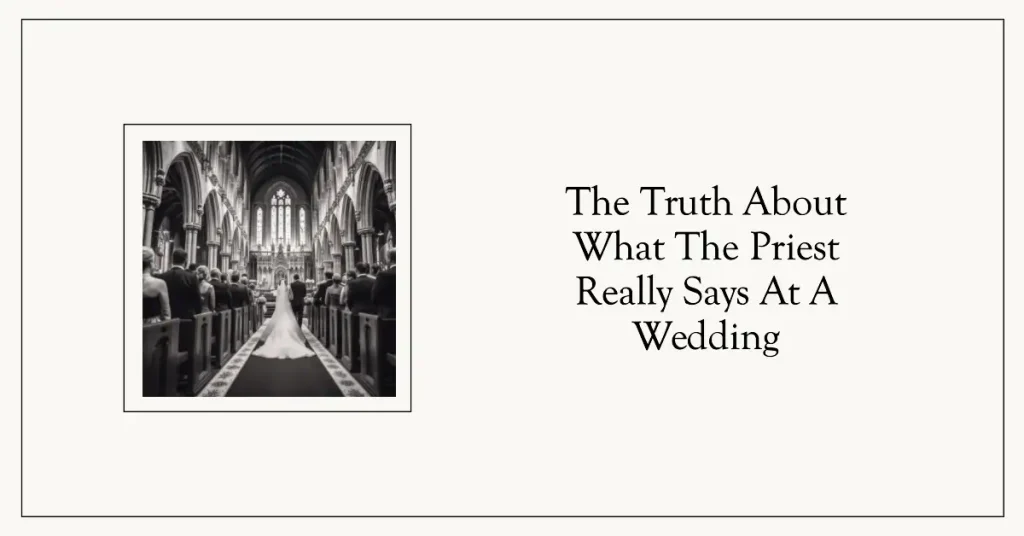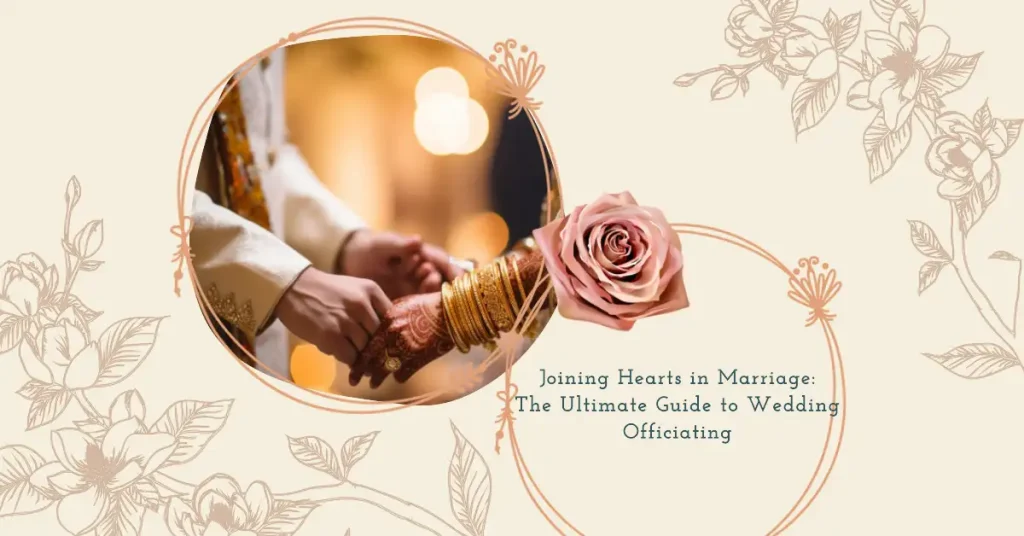Table of Contents
The priest leads the wedding ceremony, guiding the couple through the exchange of vows and rings, and offering a final blessing. Their words bless and sanctify the couple’s union in the church and community.
You might wonder about the significance of a priest’s role in a wedding ceremony. After all, they’re the ones guiding you and your partner through one of the most important moments in your life. In this article, we’ll explore the various elements of a traditional wedding ceremony and the words spoken by the priest.
What Does the Priest Say During The Processional?
As the wedding ceremony commences, you and your partner prepare to make a grand entrance. The processional, a cherished tradition, marks the beginning of your special day. As you walk down the aisle, your priest stands at the altar, ready to welcome you, your partner, and your guests to this momentous occasion.
- Carter, Lisa (Author)
- English (Publication Language)
- 107 Pages - 04/06/2024 (Publication Date) - Independently published (Publisher)
In many ceremonies, the processional follows a particular order, beginning with the grandparents and parents, followed by the wedding party, and finally, the bride and groom. Each participant’s entrance carries a specific meaning, representing their role in supporting and celebrating your union.
The priest often remarks on the symbolism behind the entrance as you and your partner approach the altar. They might reference the journey you have undertaken thus far, both individually and as a couple, and how it has culminated in this beautiful moment. Your walk down the aisle signifies not only the path you’ve travelled but also the new adventure you’re about to embark on together.
In some traditions, the bride’s entrance is accompanied by her father, who symbolically “gives her away” to her future spouse. This gesture represents the merging of two families and the creation of a new one. The priest may acknowledge this act, emphasizing the significance of family and the bonds that are being strengthened through your marriage.
As the processional comes to an end, the priest invites everyone to take their seats, and the ceremony proceeds. This beautiful and symbolic entrance sets the stage for the rest of the wedding, imbuing it with a sense of unity, love, and anticipation for the journey ahead.
The Invocation and Opening Prayer
As the ceremony unfolds, the priest begins with an invocation, a call for the divine presence to grace and bless your union. They may address the deity or higher power revered by you and your partner, acknowledging the spiritual foundation upon which your marriage is built.
The invocation serves as a reminder that your relationship transcends the physical realm, uniting you not only in the eyes of your loved ones but also within the spiritual dimension. Your priest may incorporate verses or passages from sacred texts, reinforcing the sanctity of your vows and the significance of your commitment to each other.
Following the invocation, the priest offers an opening prayer, setting a tone of love, commitment, and reverence for the ceremony. This prayer often expresses gratitude for the gift of your relationship and the opportunity to celebrate your love in the company of friends and family. It may also include petitions for wisdom, guidance, and strength as you navigate the joys and challenges of married life together.
In crafting this prayer, your priest considers your personal beliefs, values, and wishes, ensuring that the words spoken resonate with your unique love story. As the congregation listens and joins in the prayer, a sense of unity and support surrounds you and your partner, establishing a sacred atmosphere that permeates the entire ceremony.
The invocation and opening prayer serve as the spiritual cornerstone of your wedding, reminding everyone present of the divine blessings and the profound love that underpin your union. With this foundation in place, you and your partner embark on the next phase of your journey with open hearts and the assurance of spiritual support.
Declaration of Intent
At the heart of your wedding ceremony lies the Declaration of Intent, a critical moment in which the priest seeks confirmation of your desire to marry one another. They pose a simple yet profound question, asking whether you enter this union freely, voluntarily, and with a wholehearted commitment to each other. This exchange holds great significance, emphasizing the importance of free will and unwavering dedication in your relationship.
In response to the priest’s query, you and your partner each affirm your intentions by declaring “I do” or “I will,” thereby expressing your mutual desire to forge a lasting bond. This moment serves as a powerful reminder that the decision to marry is a deliberate and conscious choice, made in full awareness of the responsibilities and joys that come with marriage.
The Declaration of Intent also provides an opportunity for you and your partner to reflect on the depth of your commitment to one another. By affirming your desire to marry, you acknowledge that your love transcends fleeting emotions and circumstances, instead representing a steadfast and enduring connection.
As the congregation bears witness to this exchange, they gain insight into the love and dedication that define your relationship. The Declaration of Intent serves as a testament to the strength of your bond, inspiring those present to support and uplift you as you embark on this new chapter of your lives together.
With this essential foundation established, your priest guides you through the subsequent elements of the ceremony, each one building upon the other to create a rich tapestry of love, commitment, and spiritual unity.
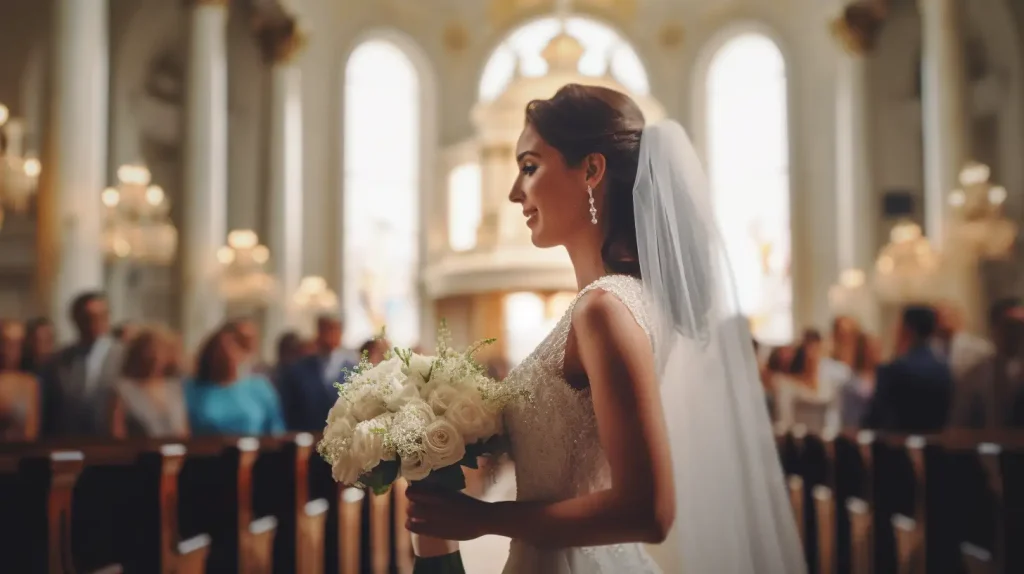
Readings and Sermons
During the ceremony, your priest often includes readings and sermons to provide further depth and context to your special day. These readings may be drawn from religious texts, poetry, or other literary works that hold special meaning for you and your partner. Chosen thoughtfully, these passages have the power to illuminate the beauty and complexity of your love story, offering insights that resonate with your unique journey.
Your priest may consult with you in advance to select readings that align with your personal beliefs, values, and preferences. This collaborative effort ensures that the passages chosen contribute to an authentic and heartfelt celebration of your love.
In addition to the readings, your priest delivers a sermon, drawing upon their knowledge, experience, and understanding of your relationship. Through their words, they impart guidance and wisdom to support you and your partner as you navigate the challenges and triumphs of married life. The sermon may touch upon themes such as the importance of communication, patience, and forgiveness, providing practical advice to nurture and sustain your bond.
By weaving together personal anecdotes, sacred texts, and time-honored wisdom, the priest crafts a message that both honors your unique love story and connects it to the broader human experience. This moment of reflection encourages you and your partner to contemplate the deeper aspects of your relationship, inspiring you to continue growing and evolving together.
Through the power of readings and sermons, your priest helps to create a ceremony that not only celebrates your love but also imparts valuable lessons and insights to carry with you as you embark on your journey as a married couple.
The Exchange of Vows
The exchange of vows is a deeply moving and intimate moment in which you and your partner articulate the depth of your commitment to one another. With the guidance of your priest, you have the opportunity to express either personal or traditional vows, each reflecting the sacred promises that will shape your lives together.
Personal vows allow you and your partner to share your feelings, dreams, and aspirations in your own words. These vows often capture the essence of your relationship, highlighting the unique qualities that drew you together and the shared values that will sustain your bond in the years to come. Your priest may offer support and guidance as you craft your personal vows, ensuring that your words truly reflect the spirit of your union.
Alternatively, you may choose to recite traditional vows, time-honored expressions of love and commitment that have resonated with couples for generations. These vows often encompass universal themes such as love, honor, and fidelity, providing a powerful foundation for your marriage. In this case, your priest may help you select the version of the traditional vows that best aligns with your beliefs and values.
Regardless of the type of vows you choose, your priest plays a crucial role in guiding you through this profound exchange. They may offer words of encouragement or affirmation, underscoring the gravity of your promises and the significance of this moment in your lives.
As you and your partner exchange vows, you pledge your love, loyalty, and devotion to one another, creating an unbreakable bond that will stand the test of time. This sacred exchange serves as the cornerstone of your marriage, a testament to the depth of your commitment and the enduring power of your love.
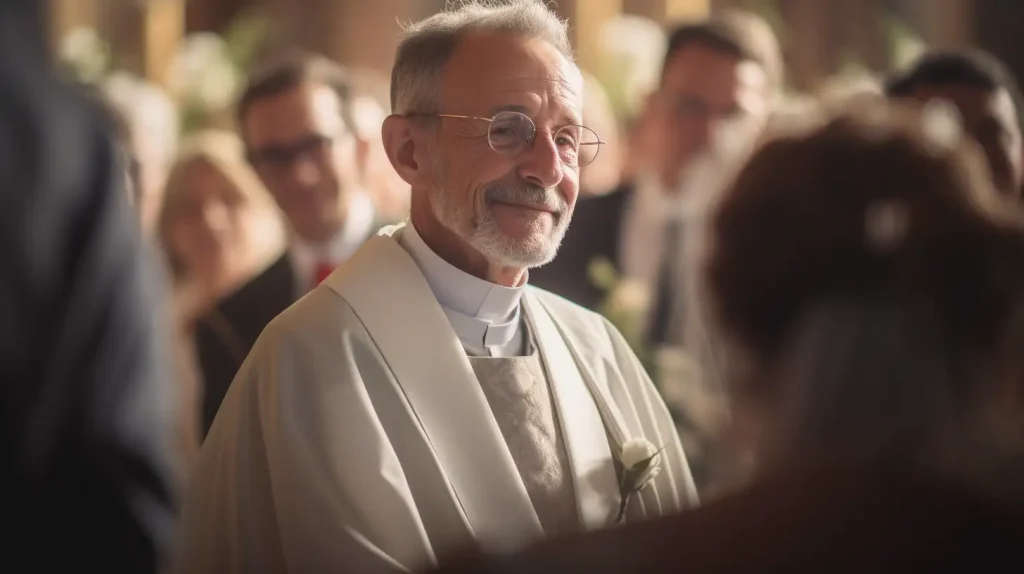
The Ring Ceremony
Following the exchange of vows, you and your partner partake in the ring ceremony, a cherished tradition that further solidifies your bond. As you prepare to exchange rings, your priest blesses these tokens, acknowledging the profound symbolism of the eternal circle. They remind you that these rings not only serve as tangible reminders of your vows but also as representations of your unending love and commitment to each other.
The circular shape of the rings holds deep significance, symbolizing eternity, continuity, and the unbreakable nature of your bond. With no beginning or end, the rings serve as a testament to the enduring quality of your love, which transcends time and life’s many challenges.
During the ring ceremony, your priest may offer a brief prayer or blessing over the rings, invoking divine guidance and protection for your marriage. They may also share insights into the meaning of the rings, connecting their symbolism to your unique love story and the journey you have undertaken as a couple.
As you and your partner place the rings on each other’s fingers, you reaffirm the vows and promises made moments earlier. This symbolic act strengthens the connection between you, reminding you of the unwavering commitment that lies at the foundation of your marriage.
What Does the Priest Say at the Pronouncement?
After traversing the ceremony’s many rituals and exchanges, you and your partner arrive at a moment of profound joy and celebration – the pronouncement. With heartfelt words and a warm smile, your priest declares your new status as a married couple, officially uniting you in the eyes of your loved ones and the greater community.
This declaration is more than a mere formality; it represents the culmination of your journey through the wedding ceremony and the beginning of your new life together. The pronouncement acknowledges the love, commitment, and dedication you’ve displayed throughout the ceremony, as well as the support and blessings of your friends, family, and spiritual guides.
Your priest’s words may vary, but the sentiment remains the same – a joyful proclamation of your union and a celebration of the bond you have forged. They might say, “By the power vested in me, I now pronounce you husband and wife” or “I now declare you to be married, partners for life.” Regardless of the exact phrasing, their words resonate with the deep love and respect that you and your partner share.
As the pronouncement echoes through the room, a wave of emotion sweeps over you, your partner, and your guests. This is the moment you’ve been waiting for, the instant in which your love and commitment become irrevocably entwined. With your priest’s declaration, you step confidently into the next phase of your journey, hand in hand, hearts forever united.
The Nuptial Blessing
As the ceremony approaches its conclusion, your priest bestows upon you and your partner the nuptial blessing, a heartfelt prayer seeking divine guidance, wisdom, and protection for your marriage. This cherished tradition serves as a poignant reminder of the spiritual dimension of your union and your shared hope for a strong, lasting bond.
Through the nuptial blessing, the priest invokes blessings of love, understanding, and mutual respect, ensuring that your relationship flourishes in the face of life’s challenges and joys. They may call upon the divine to grant you and your partner the strength to weather the storms of life, the wisdom to make sound decisions, and the grace to forgive and grow together.
The priest may also ask for blessings of health, happiness, and prosperity, expressing the hope that your marriage will be a source of joy and fulfillment for both of you. As they speak these words, their prayers reflect not only your own aspirations for your union but also the love and support of your friends and family, who have gathered to witness this sacred moment.
In bestowing the nuptial blessing, your priest unites the congregation in a shared expression of faith, hope, and love, creating a powerful spiritual energy that envelops you and your partner. This timeless ritual serves as a reminder that your marriage is not only a personal and emotional commitment but also a sacred bond that transcends the physical realm.
The Sign of Peace
As your wedding ceremony unfolds, your priest seeks to create an atmosphere of warmth, unity, and community support for you and your partner. One way they achieve this is by inviting everyone present to share goodwill and love through the exchange of the sign of peace. This meaningful gesture encourages a sense of connection and belonging among your loved ones, fostering a nurturing environment in which your marriage can flourish.
The sign of peace is a symbolic act that varies across different cultures and religious traditions. It may involve a simple handshake, a warm hug, or a bow of the head, but the underlying message remains the same: a heartfelt expression of love, friendship, and unity among all those who have gathered to celebrate your union.
As your priest invites the congregation to exchange the sign of peace, they encourage everyone to set aside any differences or grievances and to come together in the spirit of harmony and mutual support. This act of reconciliation and unity underscores the importance of community in your married life, reminding you and your partner that you are not alone in your journey.
By sharing the sign of peace, your loved ones create a powerful and uplifting energy that envelops you and your partner, reinforcing the love and commitment you have pledged to one another. This harmonious atmosphere serves as a foundation for the support and encouragement that your friends and family will provide throughout your life together.
With this simple yet profound gesture, your priest helps to weave a tapestry of love and unity, ensuring that your wedding day is not only a celebration of your individual love story but also a testament to the power of community and shared goodwill.
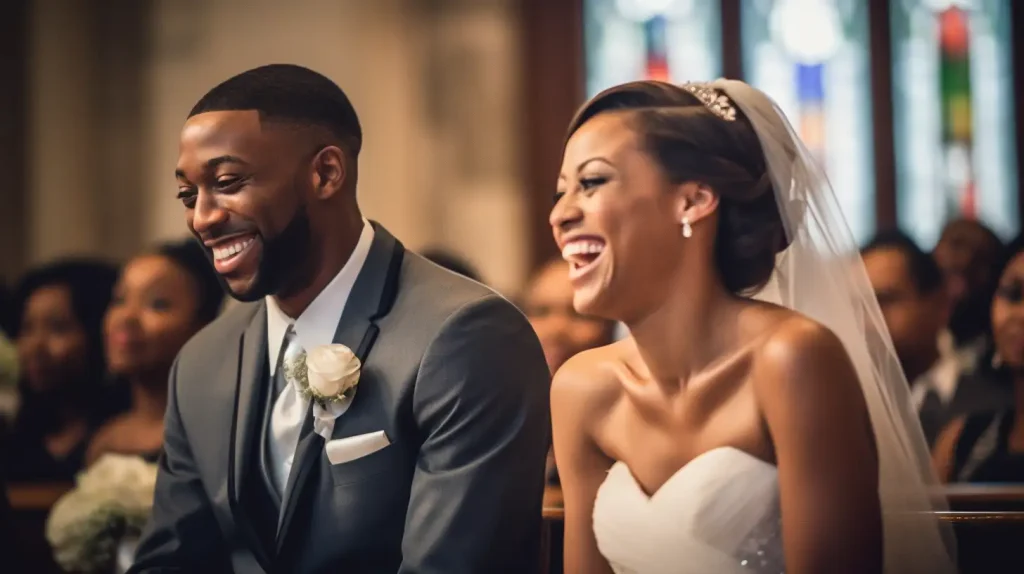
The Recessional
As the wedding ceremony draws to a close, the priest joyfully ushers you and your partner into the next chapter of your lives together. With the final blessings bestowed and the celebration of your union complete, the recessional begins, marking your first steps into married life.
As you walk hand-in-hand back down the aisle, the love and support of your friends, family, and community envelop you. This triumphant moment signifies not only the end of the ceremony but also the beginning of a new and exciting journey as a married couple.
The recessional often takes place to the accompaniment of music, which may be a traditional piece or a song that holds personal significance for you and your partner. This uplifting soundtrack serves as the backdrop for your graceful exit, infusing the air with a sense of joy, hope, and anticipation for the future.
As you make your way down the aisle, your guests shower you with their well-wishes and heartfelt congratulations. Their smiles, applause, and shared happiness are a testament to the love and support that will accompany you throughout your life together.
In this moment, the priest’s role transitions from guiding the ceremony to celebrating your newly forged bond. They may join in the festivities or offer a final word of encouragement, ensuring that your journey as a married couple begins on a high note.
The recessional is a poignant reminder that, while your wedding day is a significant milestone, it is just the beginning of your life’s adventure together. With every step you take down the aisle, you carry with you the love, support, and blessings of all those who have shared in this momentous occasion, providing a solid foundation for your future as a married couple.
Conclusion – What Does the Priest Say at a Wedding
We trust that this article has illuminated the pivotal role a priest plays in a wedding ceremony. Through their words, wisdom, and guidance, they create an atmosphere of beauty, depth, and spirituality, infusing your special day with a sense of profound meaning that will resonate throughout your lives together.
From the processional to the recessional, the priest’s presence and involvement at each stage of the ceremony not only uphold time-honored traditions but also offer invaluable support and counsel to you and your partner. By leading prayers, delivering sermons, and guiding you through the exchange of vows and rings, they help to weave a tapestry of love and commitment that will serve as the foundation of your marriage.
In addition, the priest fosters a sense of unity and community among your loved ones, encouraging them to share in the joy and blessings of your union. Through gestures such as the sign of peace and the nuptial blessing, they create a nurturing environment that will support and sustain your relationship in the years to come.
In conclusion, the priest’s role in a wedding ceremony is multifaceted and deeply significant. Their presence adds a layer of richness and spiritual depth to your special day, ensuring that your wedding is not only a celebration of your love story but also a sacred and transformative experience that will remain etched in your hearts forever.
FAQs
Q: Is there a specific script that the priest follows during a wedding ceremony?
A: While there may be variations depending on the couple’s preferences and the specific church or denomination, there is typically a standard script that the priest will follow during a wedding ceremony.
Q: Can the couple personalize the words spoken by the priest during their ceremony?
A: It depends on the specific church or denomination’s rules and the preferences of the officiating priest. Some may allow for personalization, while others may require strict adherence to a standard script.
Q: What is the significance of the final blessing given by the priest?
A: The final blessing is a way for the priest to ask for God’s blessing on the couple’s union and to offer words of encouragement for their future together.
Q: Are there any particular words of advice or guidance that the priest may offer during a wedding ceremony?
A: The priest may offer words of advice or guidance on topics such as the importance of communication, the commitment to love and support one another, and the significance of the sacrament of marriage.
Q: Can non-Catholics have a Catholic priest officiate their wedding?
A: Yes, non-Catholics can have a Catholic priest officiate their wedding, but they may be required to go through certain steps such as premarital counseling and obtaining a dispensation from their local bishop.
Q: Are there any restrictions on the type of music that can be played during a Catholic wedding ceremony?
A: Yes, there are some restrictions on the type of music that can be played during a Catholic wedding ceremony. The music should be appropriate for the sacred nature of the occasion and should not include any lyrics or themes that conflict with Catholic teachings.
Q: Can divorced individuals have a Catholic wedding?
A: It depends on the individual’s specific circumstances and the rules of the local diocese. In general, the Catholic Church recognizes the sanctity of marriage and may require an annulment or other steps before allowing a divorced individual to marry in the Church.
Q: What is the role of the wedding party during a Catholic wedding ceremony?
A: The wedding party typically serves as witnesses to the marriage and may participate in various parts of the ceremony, such as the readings or bringing up the offertory gifts.
Q: Can the bride and groom write their own vows for a Catholic wedding ceremony?
A: While the Catholic Church has a traditional set of wedding vows, many priests may allow the bride and groom to write their own vows or incorporate personal touches into the ceremony, as long as they remain in line with Catholic teachings.
Q: Does the priest need to be a family member or friend to officiate a wedding?
A: No, the priest does not need to be a family member or friend to officiate a wedding. Most couples choose a priest who is affiliated with their church or religious denomination to officiate their wedding.
Q: What is the difference between a Catholic wedding and a non-denominational wedding?
A: A Catholic wedding is a sacrament and involves specific rituals and traditions of the Catholic Church. A non-denominational wedding is usually more flexible and can include a variety of religious or secular elements based on the couple’s preferences.
Q: What should the couple do if they have questions or concerns about the wedding ceremony?
A: The couple should communicate with their priest or officiant and ask any questions or express any concerns they may have about the ceremony. They should also be familiar with the rules and traditions of their specific church or religious denomination.
Q: How long does a Catholic wedding ceremony typically last?
A: A Catholic wedding ceremony typically lasts between 45 minutes to an hour, depending on the specific elements included in the ceremony.
Q: What should the couple do if they want to have a Catholic wedding but one of them is not Catholic?
A: The couple should discuss their situation with their local priest or the Catholic Church’s marriage preparation office to explore their options and any requirements they may need to fulfill before getting married in the Church.
Key Takeaways
- The priest plays a significant role in a wedding ceremony, guiding the couple through the exchange of vows, rings, and offering a final blessing.
- During the processional, the priest often remarks on the symbolism behind the entrance, highlighting the journey the couple has taken and the new adventure they are about to embark on together.
- The priest begins the ceremony with an invocation, calling for divine presence to bless the union and acknowledging the spiritual foundation of the marriage.
- The declaration of intent is a critical moment where the priest confirms the couple’s desire to marry, emphasizing the importance of free will and commitment in the relationship.
- Readings and sermons are included in the ceremony to provide further depth and context, often chosen based on the couple’s beliefs and values.
- The exchange of vows is a deeply intimate moment where the couple expresses their commitment to each other. Personalized or traditional vows can be used.
- The ring ceremony follows the vows, with the priest blessing the rings and emphasizing their symbolism of eternity and unending love.
- The pronouncement is a joyful declaration by the priest, officially uniting the couple in the eyes of their loved ones and the community.
- The nuptial blessing is a heartfelt prayer seeking divine guidance and protection for the couple’s marriage.
- The sign of peace encourages a sense of connection and unity among the guests, fostering a supportive environment for the couple.
- The recessional marks the end of the ceremony and the beginning of the couple’s new life together, accompanied by well-wishes and congratulations from their loved ones.
COPYRIGHT NOTICE
Please be advised that all images, designs, and creative content on this page are the exclusive property of TheIDoGuide.com and are protected under international copyright laws. The images may not be reproduced, copied, transmitted or manipulated without the written permission of TheIDoGuide.com.
Unauthorized use, distribution, display, or creation of derivative works of any images contained on this site, is strictly prohibited and can lead to legal penalties. We actively monitor for, and enforce, our copyright interests.
If you wish to use any of our images, kindly contact us to seek permission. Respect of copyright is not merely a legal requirement but also an acknowledgement and support of the hard work and creativity that goes into producing them.
Thank you for your understanding and cooperation.
© 2023, TheIDoGuide.com. All Rights Reserved.

